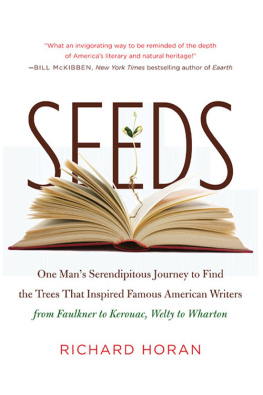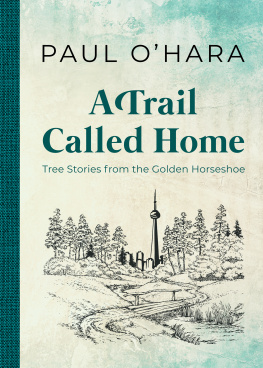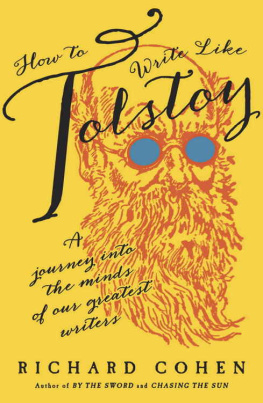I never saw a discontented tree.
I GREW UP IN SUBURBIA . I remember the houses and the people and the schoolyards, but I remember the trees most of all. I remember the smell of them in spring, redolent of pollen. I remember them in summer, plump and green, large as churches. I have visions of them in fall, brilliant with color, as dazzling as the circus. I see them standing still in winter, somber but steadfast.
I remember the red maple tree out in front of my own house, more a playmate than a plant. I used to sit up in the topmost branches and look out over the world like a crow, imagining infinite forests, unbound freedom, and life before cars and cities.
I have come to believe that where we played as children, so utterly consumed in the moment, is intricately woven into our emotional and intellectual circuitry and we carry the leafy landscapes and odors in our souls throughout our journey on earth. Even if we dont encounter trees early on, we find them around us at critical points in our liveswhen we are in love, in turmoil, at peace.
In so many yards and parks across America, ancient trees have stood proud, watching all like gods. They are both the silent witnesses of and active partners in our personal history.
During collegethe last rite of childhoodI had a philosopher/ naturalist friend who had gone to forestry school before transferring to Boston College. He knew the names of all the trees. Oftentimes we would ramble through the neighborhood, near St. Johns Seminary or around the great reservoir at Cleveland Circle, discussing Thoreau, Emerson, and Nietzsche. And as we strolled along, he would occasionally stop to identify a species and talk about its uses and outstanding characteristics. It was a perfect complement to our inspired ramblings, like a good bottle of wine with a gourmet meal. Ever since then, I have always stopped to notice the trees.
T REES ARE THE PLANET S most precious resource. They provide us with our life-giving breath. They are home and harvest to so many creatures of this green earth. Together they form the wild jungles and dark forests that embody our sense of awe and wonder. As a species, we are but children, and not too long ago our ancestors climbed down from the safety of the trees arms to walk the earth on two legs. But we seem to have forgotten our arboreal origins.
More often than not, trees are seen as just being in the way; we are destroying them at a catastrophic rate. Where are we growing to? I wonder.
Thankfully there is hope, with organizations and initiatives such as the Sierra Club, the Arbor Day Foundation, The TREE Fund, the Tree of Peace Society, The Nature Conservancys Wildlife Corridor project, and the Billion Tree Campaign.
As a writer, I have made a solemn oath to the trees to write only what is necessary, for every page of printed material is a precious piece of wood flesh. There is no other art form that is so dependent on a living species.
There is much to be written, but there is far more to be revered.
Germination
There he began thrusting his iron rod into the earth, making a hole in which he planted an acorn; then he refilled the hole. He was planting oak trees. I asked him if the land belonged to him. He answered no. Did he know whose it was? He did not. He supposed it was community property, or perhaps belonged to people who cared nothing about it. He was not interested in finding out whose it was. He planted his hundred acorns with the greatest care.
JEAN GIONO , THE MAN WHO PLANTED TREES

D URING THE SPRING BREAK OF 2001, my wife, our two daughters, and I went on a vacation to the Gulf of Mexico. Destination: Dauphin Island, Alabama. We drove from our home in Wisconsin, covering more than a thousand miles of interstates and back roads. To break up the drive, we put together an itinerary of historical places to visit along the way.
First stop: Springfield, Illinois, and Abraham Lincolns home. Originally just a cottage, the place was expanded by the Lincolns into a two-story, twelve-room house soon after they moved in. When we visited it, the saltbox colonial had an overabundance of creaking stairways, paisley wallpaper, crimson carpets, and primitive-looking furniture. And it smelled funny.
My youngest daughter, just seven at the time, was dazzled by it. I felt it lacked all freedom of interior and exterior occupation, to borrow a phrase from Frank Lloyd Wright, but then again, the young Lincoln was not noted for his architectural contributions to the house, just his legendary prowess there with an adz.
In the living room, a photograph caught my eye: a picture taken in May of 1860 of Honest Abe standing out in front of the house next to a young basswood tree. Coincidentally, there was a fully mature basswood in that same spot just outside the window.
Say, is that the same tree as the one in the photograph? I blurted out.
I believe it is, the docent replied.
I felt a thrill run down my spine.
It was the perfect excuse to escape, so I left the family behind to continue the malodorous tour while I went outside to take a closer look at the ancient hardwood that had known Lincoln personally. There was nothing special about the treeno patina-proud plaque pointing out its pedigree, no initials carved into the bark, no tattered rope swing. It looked like any other tree. On the ground and underfoot were scads of golden pea-size seeds. I dont know what possessed me, but I reached down and picked up a handful and jammed them into my pockets.
This tree had known one of the greatest and most complex figures in American history. Had Lincoln even leaned against it and pondered his future? Surely he mustve dreamed under that tree, dreamed of a better life for his family, for his fellow citizens, black and white. Suddenly those seeds in my pocket from that touchstone felt like pennies from heaven.
N EXT STOP : H ANNIBAL , M ISSOURI , on the western banks of the Mississippi River, just an hour and a half from Springfield. At Mark Twains childhood home, we were disappointed to learn that we had missed the last guided tour of the day. I searched the yard for old trees and seeds. Nothing. But Hannibal itself was old and seedy, surprisingly untransformed by its one-time residents fame. Later that evening, while my brood swam in the indoor pool at the hotel, I decided to have a look around town in the waning sunlight.
Because I have been a transient most of my life, I have a knack for bonding quickly with any given locale. I need only wander around a place for a little while to feel a keen sense of belonging. As a teacher, Ive learned that someones environment has as much to tell us about that person as does his or her friends and family. So, within the hour, Ich bin ein Hannibaler .
I came to the base of Cardiff Hill, that illustrious playground of Tom Sawyer and Huckleberry Finn. A rusty sign modestly boasted of the sites place in literary history. As I made my way up the steep incline along a narrow dirt path, I half expected two waifs to come bouncing out of the bushes in rolled-up dungarees, wooden swords in hand, battling make-believe pirates.













